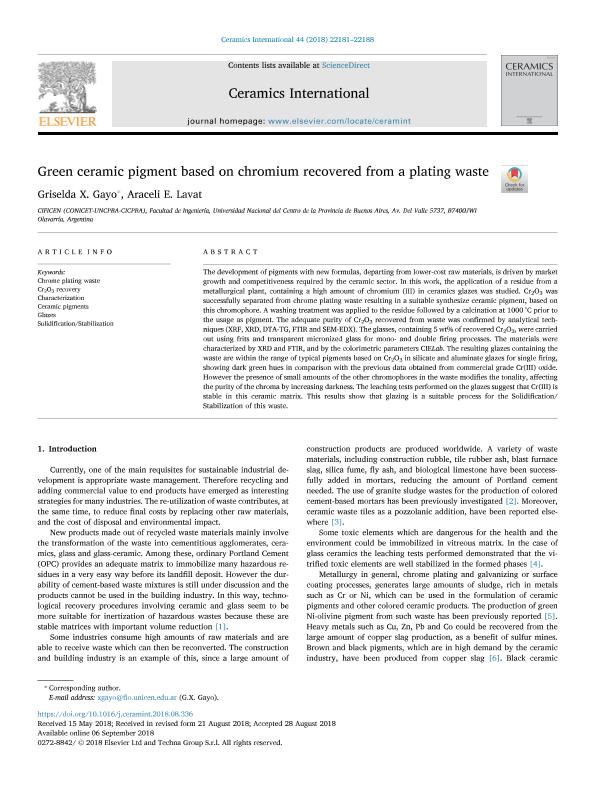Mostrar el registro sencillo del ítem
dc.contributor.author
Gayo, Griselda Xoana

dc.contributor.author
Lavat, Araceli Elisabet

dc.date.available
2019-11-11T21:03:42Z
dc.date.issued
2018-12
dc.identifier.citation
Gayo, Griselda Xoana; Lavat, Araceli Elisabet; Green ceramic pigment based on chromium recovered from a plating waste; Elsevier; Ceramics International; 44; 18; 12-2018; 22181-22188
dc.identifier.issn
0272-8842
dc.identifier.uri
http://hdl.handle.net/11336/88553
dc.description.abstract
The development of pigments with new formulas, departing from lower-cost raw materials, is driven by market growth and competitiveness required by the ceramic sector. In this work, the application of a residue from a metallurgical plant, containing a high amount of chromium (III) in ceramics glazes was studied. Cr2O3 was successfully separated from chrome plating waste resulting in a suitable synthesize ceramic pigment, based on this chromophore. A washing treatment was applied to the residue followed by a calcination at 1000 °C prior to the usage as pigment. The adequate purity of Cr2O3 recovered from waste was confirmed by analytical techniques (XRF, XRD, DTA-TG, FTIR and SEM-EDX). The glasses, containing 5 wt% of recovered Cr2O3, were carried out using frits and transparent micronized glass for mono- and double firing processes. The materials were characterized by XRD and FTIR, and by the colorimetric parameters CIELab. The resulting glazes containing the waste are within the range of typical pigments based on Cr2O3 in silicate and aluminate glazes for single firing, showing dark green hues in comparison with the previous data obtained from commercial grade Cr(III) oxide. However the presence of small amounts of the other chromophores in the waste modifies the tonality, affecting the purity of the chroma by increasing darkness. The leaching tests performed on the glazes suggest that Cr(III) is stable in this ceramic matrix. This results show that glazing is a suitable process for the Solidification/Stabilization of this waste.
dc.format
application/pdf
dc.language.iso
eng
dc.publisher
Elsevier

dc.rights
info:eu-repo/semantics/openAccess
dc.rights
Atribución-NoComercial-CompartirIgual 2.5 Argentina (CC BY-NC-SA 2.5 AR)
dc.rights.uri
https://creativecommons.org/licenses/by-nc-nd/2.5/ar/
dc.subject
CERAMIC PIGMENTS
dc.subject
CHARACTERIZATION
dc.subject
CHROME PLATING WASTE
dc.subject
CR2O3 RECOVERY
dc.subject
GLAZES
dc.subject
SOLIDIFICATION/STABILIZATION
dc.subject.classification
Cerámicos

dc.subject.classification
Ingeniería de los Materiales

dc.subject.classification
INGENIERÍAS Y TECNOLOGÍAS

dc.title
Green ceramic pigment based on chromium recovered from a plating waste
dc.type
info:eu-repo/semantics/article
dc.type
info:ar-repo/semantics/artículo
dc.type
info:eu-repo/semantics/publishedVersion
dc.date.updated
2019-10-16T15:07:35Z
dc.journal.volume
44
dc.journal.number
18
dc.journal.pagination
22181-22188
dc.journal.pais
Países Bajos

dc.journal.ciudad
Amsterdam
dc.description.fil
Fil: Gayo, Griselda Xoana. Universidad Nacional del Centro de la Provincia de Buenos Aires. Centro de Investigaciones en Física e Ingeniería del Centro de la Provincia de Buenos Aires. - Consejo Nacional de Investigaciones Científicas y Técnicas. Centro Científico Tecnológico Conicet - Tandil. Centro de Investigaciones en Física e Ingeniería del Centro de la Provincia de Buenos Aires. - Provincia de Buenos Aires. Gobernación. Comisión de Investigaciones Científicas. Centro de Investigaciones en Física e Ingeniería del Centro de la Provincia de Buenos Aires; Argentina
dc.description.fil
Fil: Lavat, Araceli Elisabet. Universidad Nacional del Centro de la Provincia de Buenos Aires. Centro de Investigaciones en Física e Ingeniería del Centro de la Provincia de Buenos Aires. - Consejo Nacional de Investigaciones Científicas y Técnicas. Centro Científico Tecnológico Conicet - Tandil. Centro de Investigaciones en Física e Ingeniería del Centro de la Provincia de Buenos Aires. - Provincia de Buenos Aires. Gobernación. Comisión de Investigaciones Científicas. Centro de Investigaciones en Física e Ingeniería del Centro de la Provincia de Buenos Aires; Argentina
dc.journal.title
Ceramics International

dc.relation.alternativeid
info:eu-repo/semantics/altIdentifier/doi/http://dx.doi.org/10.1016/j.ceramint.2018.08.336
dc.relation.alternativeid
info:eu-repo/semantics/altIdentifier/url/https://www.sciencedirect.com/science/article/pii/S0272884218324210
Archivos asociados
